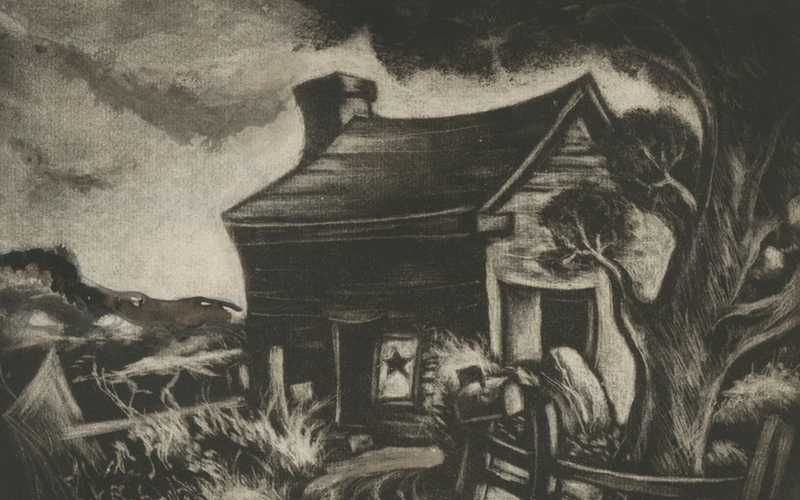Dox Thrash, an artist whose work is currently on exhibit at the Fort Wayne Museum of Art, was talented and innovative, providing work that represented the underrepresented in his era.
But more than that, his life and work have connections to the history of more than art but to history and to a variety of issues that are the core of America’s social evolution and the place of African Americans in the art world and the national stage.
Born in Georgia, Trained in Chicago
Thrash was born in Georgia in 1893 but left when he was still a teenager, hoping for more opportunities in the north. Years ahead of the Great Migration, Thrash had settled in Chicago by 1911 and began studying at the Art Institute which had begun accepting black students almost two decades earlier.
The north provided more opportunities, but Thrash still faced racism and the threat of lynching in early 20th century America. Having served in World War I, he received federal assistance to continue his studies at the Art Institute.
Upon completion of his studies, he moved between Chicago, New York, and Boston before settling into his eventual home of Philadelphia.
It was President Franklin Roosevelt’s New Deal that provided an important opportunity for Thrash who became part of the government program Works Progress Administration (WPA) Federal Art Project. The overriding goal of the WPA was to provide work for unskilled laborers who had been most affected by the Depression with a primary purpose to build roads and improve the country’s infrastructure. But the Federal Art Project made the bold assertion that public art, murals, sculptures — the kind of effort we’re seeing now in downtown Fort Wayne — was important, too, and the development of artists was an essential part of our country’s vision. In working in the project, Thrash met two other artists, Hugh Mesibov and Michael Gallagher, with whom he developed a new printing process.
A new Technique
“He developed a technique known as carborundum mezzotint,” said Sachi Yanari-Rizzo, curator of the Thrash exhibit and Curator of Prints and Drawings at the Fort Wayne Museum of Art. “Up until then it was an etching, and you used a copper plate. As you filled it in, it would get into those grooves, like an engraving.
“But Thrash didn’t like the plate, so instead he used a plate with a pitted surface so then when you put the ink in it, the pits would hold the ink. The process created a tone, a glow. It was soft and not made up of lines but of just tone. It’s a beautiful process.”
Although something new and very innovative, Yanari-Rizzo said it has not become a common means of printing, which makes Thrash’s work all that more striking.
“It didn’t really get popular after the Dox Thrash era. People today might sporadically use it. Most of his works are very small, and we have some of his watercolors and drawings in addition to his work with carborundum mezzotint.”
Perhaps most striking about his work within his lifetime (Thrash died in 1965, just nine months after the signing of the Civil Rights Act of 1964) is how he portrays African Americans.
“His work depicts images of African Americans in a way that wasn’t being done then,” Yanari-Rizzo said. “Images of African Americans were largely absent or what there was was degrading. They were derogatory images for the most part. Thrash provided an entirely different look. His female nudes were a subject that was very unusual at the time, done in a very elegant and naturalistic way. He had a work called ‘The Champ’ which was of Joe Louis who at the time was the reigning champion and a hero to many, but most of his work is of people you don’t recognize but portrayed in a very naturalistic way in their everyday life.”
Although not himself a part of it, Yanari-Rizzo sees his work in a similar light as an important artistic movement which took place in the early part of the 20th century.
“He wasn’t part of the Harlem Renaissance, but I see him as moving in a parallel world as the Harlem Renaissance. And he did live briefly in New York so I’m sure he was aware of the artists and writers and what was happening with that.”
Local Exhibit
The exhibit, “Dox Thrash: The Hopeful Gaze,” with pieces loaned to the Fort Wayne Museum of Art from the Dolan Maxwell gallery in Philadelphia, runs through August 4 and demonstrates the kind of diversity that the museum has been better able to address since their expansion and remodel several years ago.
Perhaps not a household name known to casual art fans, Thrash and his work are widely regarded in the art world. Winston Kennedy, artist and emeritus professor at Howard University, speaks to Thrash’s legacy and the importance of his work when he said, “Dox Thrash’s intaglio prints literally and figuratively represent the process of raising the image of black subjects from the shadows of zinc and copper… . Out of this shadow, through modulated light generated by a process of scraping the carborundum plate, a more representative black experience emerged.”
 Submit Your Event
Submit Your Event




